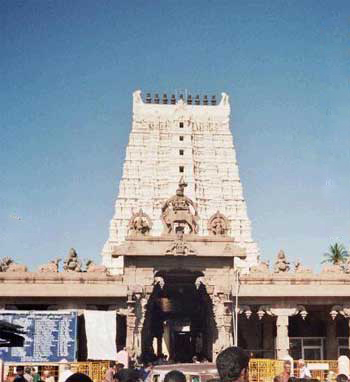-:
Hindu Temples :-
Lord Shiva Temples
Rameshwaram Temple

Rameshwaram is an island- of Lord Rama's temple at Tamil Nadu is a terrific destination. Along with being a major pilgrimage for the Hindus, Rameshwaram is a happening holiday spot too.The religious island is spread in an area of 61.8 square kilometers and happens to be in the shape of a conch. The Ramanatha Swamy Temple occupies major area of Rameshwaram. The masterpiece of Dravidian architecture boasts of the largest temple corridor in India. Different rulers built the Ramanatha Swamy Temple over a period of time starting from the 12th century. The temple comprises of twenty-two wells where the taste of the water of each well is different from the other. The waters of the wells are believed to possess medicinal properties
The temple of Sri Ramanatha, which has over the
centuries grown into its present gigantic dimensions, stands on the eastern
shore of an island, which is shaped like a conch, which Lord Vishnu bears in
one of His hands. No field is ploughed or oil presses any where in the
island. A magnificent railway bridge, over a kilometre long and constructed
at the beginning of the twentieth century, connects it with the mainland.
To help the pilgrims walking incredible distances, philanthropists used to
construct rest houses at intervals along the way. The last of them before
Rameshwaram was Thangachimadam, a few kilometres away on the island. Modern
means of transport have made these rest houses superfluous. But in their
time they were most useful, even vital. The Sethupathis of Ramanathapuram,
of which the district Rameshwaram is an administrative part, were called the
"guardians of the Sethu", the bridge which, according to tradition, was
built for Sri Rama to cross over into Sri Lanka when He set out to recover
Sita.
About The Temple
Since it was Sri Rama Himself who, in time honoured tradition, built the
temple, it is held in particular reverence. After killing Ravana, He
returned to India and, in Rameshwaram, offered worship to Lord Shiva to
expiate the sin incurred in destroying him. Intending to set up a Linga, He
directed Hanuman to bring one from Kailasa within a certain time. Hanuman
was delayed. Meanwhile, the propitious hour for the installation having
arrived, Sita Herself prepared one of sand, and offered it worship. This is
the Linga of Sri Ramanatha in the temple.
When Hanuman returned with a Linga, He found that it was too late. He was
angry and attempted to uproot the Ramalinga. But He failed. To pacify Him
Sri Rama directed that his Linga, the "Visvalinga", should also be set up
and that worship should first be offered to it. This is the second Linga
under worship in the temple.